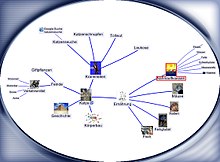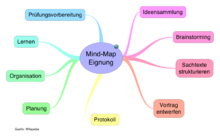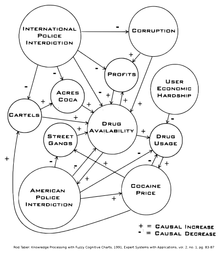Mind map
A mind map (also mind map , English mind map ; also: thoughts [land] map , memory [land] map ) describes a cognitive technique coined by Tony Buzan . B. can be used to develop and visualize a topic, for planning or for taking notes. The principle of association should help to develop thoughts freely and to use the brain's ability to create categories . The mind map is created and read according to certain rules. The process or the topic or the technology is referred to as mind mapping .
Creation
Conceptually and as a working tool, they were introduced by the British psychologist Tony Buzan . The first ideas for this came up while working on his book An Encyclopedia of the Brain and Its Use in 1971, and the Mind Map book appeared in 1997 . A mind map is created on unlined paper. In the middle, the central theme is formulated as precisely as possible and / or shown as a picture in different colors. Proceeding from this, the main topics are connected in capital letters, corresponding to the chapter headings of a book, with organic (i.e. thickly curved and thinly tapering) main lines. One key term is used for each line, whereby the line length corresponds to the word length. This is followed by the second and third and other levels of thought (subchapters) in thinning branches and using lowercase letters. Different colors for branches or topics, picture elements for the terms, 3-D for emphasis or personal codes represent relationships and cross-connections. The same colors are used, for example, for the same levels (branches of the first or second level). The mind map should be implemented in a creative and humorous way. Every branch and branch is read from the center. The mind map ends when its author decides to do so - theoretically, every word it contains can be the focus of a new mind map, as the associative abilities are unlimited.
method
From a formal point of view, mind maps consist of labeled tree diagrams . Additional comments explain content and processes. Relationships are represented by mutual links. If terms can be complex interconnected, it is called conceptual maps ( conceptual maps ), semantic networks or ontologies with which the mind map is closely related. In contrast to mind maps, these maps also have defined semantics , i.e. This means that the relationships between individual terms shown with lines and arrows have a defined meaning.
In contrast to brainstorming , in which a number of unsorted terms are produced and then sorted using the pinboard moderation , a networked structure is created in the mind map from the start. A mind map is also suitable for documenting the sorted version of a brainstorming session. With the metric evaluation of the illustrated knowledge arises a relationship with Informetrie ago, the intellectual capital created.
Mind map software
- FreeMind , a platform-independent, free mind map software under GPL license
- MindManager , a fee-based program that is specially designed for use in the business world thanks to its integration into the office landscape
- iMindMap, a commercial program co-developed by Tony Buzan himself, which allows the creation of more organic-looking mind maps and different modes and views e.g. B. integrated for brainstorming with notes.
- MindView , formerly OpenMind , a paid mind map application with MS Office integration and six interchangeable views
- XMind , a free variant with a paid Pro version for business use. Users can publish mind maps on the XMinds online platform.
The mind map tools often extend the classic mind maps with special branches that can be used to create references to files or internet sources. The mind map also brings together external data sources that are thematically related. Mind map programs also use tools for mapping projects and checklists. In addition to classic single-user mind map tools, there are also networked solutions in which the participants work on the same mind map in parallel. Application scenarios are decentralized brainstorming sessions (e.g. in the context of an online meeting ) and information collections for a company's knowledge management .
fitness
Mind maps can be used for many different things. You can use them for presentations, lectures and lectures as well as posters. There are no limits when it comes to topics. Possible uses can be found in schools, business and science.
Gathering ideas and brainstorming
Mind maps are useful for collecting ideas and brainstorming because each keyword can associate more. Large-scale mind maps can be built up through these associations.
Structure factual texts
Mind maps are also well suited to structuring somewhat confusing factual texts because they summarize and bundle all the generic terms on a topic in a clear manner, but are still detailed due to the wide ramification.
Design a lecture
They are good to use for planning lectures or speeches, because every subject area with its cross-connections can be recorded. In the lecture, the key terms can then be dealt with flexibly, which are arranged around a subject area, without losing the central theme. So-called “structograms” are also suitable for presentations; they arrange the generic terms one below the other and then connect them with a line from top to bottom. The sub-items are then collected to the right of the generic terms.
protocol
Contents from phone calls, meetings, lectures, surveys can be recorded, summarized and documented with an associogram . Chronological sequences can for example be displayed clockwise. Here, too, the graphic representation supports lasting memory.
Planning and organization
Mind maps are helpful for planning and organization because all important areas can be clearly summarized in them. In this "to-do list" you can always add things later without having to cross out or insert with brackets.
Learning, exam preparation
Mind mapping is well suited for exam preparation, as a clear presentation of the learning material is developed in creative steps and the material learned is consolidated later through systematically repeated engagement with this reproduction. Such a clear arrangement of the semantic structure of knowledge promotes stable rememberability over long periods of time. When building the mind maps, no more than seven sub-branches should be assigned to a branch. This encourages you to take a photo of the mind maps while you are studying and to go through them systematically in your mind during the exam. Extensive information such as lecture notes and the like can be reproduced in this way.
Mind maps are also suitable for learning foreign languages, foreign words and technical terms. Linking words and terms with pictures helps you remember everything better.
Performance benefits
Due to the "brain-friendly" structure of mind maps, facts are easy to remember and can easily be stored in the memory. Furthermore, the essence of what is to be learned is formed immediately. Unnecessary words that often appear in sentences do not have to be learned. This is also achieved through the necessary creativity and the connection between word and image. Mind maps are a versatile medium due to the possibility of creating them by computer or by hand and can therefore be used optimally for lectures as well as personal notes and the effort in both cases is adapted to the requirements of their purpose. They are also ideal for archiving, whether electronically or by hand. Because mind maps are easier to add than linear recordings, structures can be improved, and new items that are to be included in the transcript over several appointments can be added more easily without having to make large deletions.
Because they clearly emphasize the main idea, ideas can be better assessed that you can no longer see "the forest for the trees", so that rarely happens because the most important thing is clearly closer to the center, in the middle of the sheet, less important is more on the edge. One advantage over the representation in a linear table form is z. B. in the fact that links between the terms can be shown.
defects
It is criticized that the various positively emphasized aspects of using a mind map are plausible, but not scientifically proven.
Furthermore, it is countered that mind maps are essentially only a tool for the author and not for the reader, because the chosen key terms are often very individual and not understandable for others, the structure of the information is often only understandable for the author and the same problem is the symbols and colors used. In other words, a mind map is not self-explanatory, so it has to be presented and explained to the reader, but is at least suitable for (commented) presentations.
The restriction to a mono-hierarchical structure sometimes leads to redundancies or loss of information if complex ontologies are reduced to taxonomies . To circumvent the restriction to a mono-hierarchical tree structure, partial aspects are often classified under several keywords and relationships between keywords are indicated by additional "branch connections". Mind maps can quickly lose their clarity.
The levels - i.e. the hierarchical classification of the terms - are only immediately apparent in simple cases. Often hierarchies are changed in the processing phase; Therefore it is regularly necessary to deal very long and intensively with the structure of a mind map in order to create a logical and consistent mind map - which, however, is an advantage of the method under certain aspects.
Different structures and collections of ideas are not necessarily less suitable as tools than a mind map. Mind maps are no longer suitable as an overview if there is a certain amount of information to be transported. Associative learning methods can just as easily be achieved with other structures.
Mind maps versus cognitive maps
Mind maps have a tree structure. In practical recursive thinking, however, the connection of concepts is not necessarily limited to a tree structure. All concepts interact with one another. Such structures can be better represented with cognitive maps (cognitive status diagrams). For this purpose, Hasse diagrams or matrices are used with which calculations for simulations are possible. When the computation of fuzzy logic ( fuzzy logic ) is derived, it is Fuzzy Cognitive Maps (FCMs). FCMs are “acyclic or cyclic causal predictor systems. From the standpoint of structural modeling theory, FCMs are fuzzy, directed graphs (digraphs) ”. Represented as a matrix (example: drug crime), FCMs can also be used to calculate the interactions between the cognitive states of a thought process or the factors of a project, for example. In his book Fuzzy Thinking, Bart Kosko points to other good examples, including another application for politics that links eleven components of drug crime in an FCM and thus illustrates the risk of monocausal approaches in politics.
Mind maps versus iMapping
Like mind maps , iMaps have a hierarchical basic structure, but they map hierarchies more flexibly in the iMapping tool due to their nesting principle and their zoom function. In contrast to the mind map, an unlimited amount of information can be included in the iMap. In addition, unlike mind maps, in which connections only represent hierarchies, cross-connections can be inserted.
Web links
literature
- Maria Beyer: Brainland - Mind Mapping in Action . 3rd edition, Junfermann, Paderborn 2002, ISBN 3-87387-101-7 .
- Tony Buzan, Barry Buzan: The Mind Map Book. The best way to increase your intellectual potential . Moderne Verlagsgesellschaft, Munich 2002, ISBN 3-478-71731-0 .
- Tony Buzan, Vanda North: Mind Mapping. The way to your personal success . öbv & hpt Verlag, Vienna 2005.
Individual evidence
- ↑ Benjoe A. Juliano, Wylis Bandler: Tracing Chains-of-Thought. Fuzzy Methods in Cognitive Diagnosis . Physica-Verlag Heidelberg 1996. ISBN 3-7908-0922-5 .
- ↑ Jens Krefeldt: VIS - Visual Interaction Structure. A component-based framework for the visualization of interaction and graph structures . University of Oldenburg, July 19, 2004. (In this work, different types of visualization are described, including mind maps.)
- ↑ FCM calculations .
- ↑ Bart Kosko: Fuzzy Logical. A new way of thinking . 1993/1995. ISBN 3-612-26161-4 . (English: ISBN 0-7868-8021-X , Chapter 12: Adaptive Fuzzy Systems .)
- ^ Rod Taber: Knowledge Processing with Fuzzy Cognitive Maps. Expert Systems with Applications . 2nd edition, No. 1. 1991. Pages 83-87.



